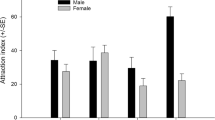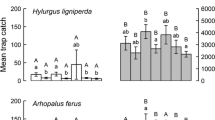Abstract
Adult females of Xestobium rufovillosum de Geer demonstrated anemotactic orientation when exposed to an odor plume containing volatiles generated by wood-decaying fungi (Coriolus versicolor, Donkioporia expansa) and decayed oak wood (Quercus petraea, Quercus robur). They did not orient towards undecayed oak wood, beech (Fagus sylvatica), or pine wood (Pinus sylvestris). Although all insects tested showed anemotactic orientation, responses were nonlinear with respect to insect age. Adult females more readily oriented upwind when they were between 10 and 16 days old. Oviposition choice bioassays showed that ovipositing females would preferentially oviposit on extract-treated cellulose paper discs that had been treated with various strains of the wood-decaying fungus, Donkioporia expansa. HPLC-fractionated mycelial extracts were attractive to ovipositing deathwatch beetles, whereas HPLC-fractionated fungal broth extracts were repellent to ovipositing females. The implications of these results are discussed in the context of timber pest management in historically important buildings.
Similar content being viewed by others
REFERENCES
Akers, R. P., and Wood, D. L.1989. Olfactory orientation responses by walking female Ips paraconfususbark beetles II. An anemotaxis assay. J. Chem. Ecol.15:147–1159.
Bell, W. J., and Kramer, E.1979. Search and anemotaxis in cockroaches. J. Insect Physio.25:631–640.
Bell, W. J., Kipp, L. R., and Collins, R. D.1995. The role of chemo-orientation in search behaviour, pp. 105–153, inR. T. Cardé and W. J. Bell (eds.). Chemical Ecology of Insects II. Chapman and Hall, London.
Belmain, S. R., Blaney, W. M., and Simmonds, M. S. J.1998. Host selection behaviour of deathwatch beetle, Xestobium rufovillosumde Geer (Coleoptera: Anobiidae): Oviposition preference choice assays testing old vs. new oak timber, Quercussp. Entomol. Exp. Appl.89:193–199.
Blaney, W. M., Simmonds, M. S. J., Ley, S. V., and Katz, R. B.1987. An electrophysiological and behavioural study of insect antifeedant properties of natural and synthetic drimane related compounds. Physiol. Entomol.12:281–291.
Blaney, W. M., and Simmonds, M. S. J.1990.Abehavioural and electrophysiological study of the role of tarsal chemoreceptors in feeding by adults of Spodoptera, Heliothis virescensand Helicoverpa armigera. J. Insect Physiol.36:743–756.
Day, J. F., and Sjogren, R. D.1994. Vector control by removal trapping. Am. J. Trop. Med. Hyg.50:126–133.
Esser, P., and Tas, A.2001. The roles of location, age and fungal decay in the chemical composition of oak. Eng. Herit. Res. Trans.4:79–86.
Fisher, R. C.1937. Studies of the biology of the deathwatch beetle, Xestobium rufovillosumde Geer: Part I, A summary of the past work and a brief account of the developmental stages. Ann. Appl. Biol.24:600–613.
Fisher, R. C.1938. Studies of the biology of the deathwatch beetle, Xestobium rufovillosumde Geer: Part II, The habits of the adult with special reference to the factors affecting oviposition. Ann. Appl. Biol.25:155–180.
Fisher, R. C.1940. Studies of the biology of the deathwatch beetle, Xestobium rufovillosumde Geer: Part III, Fungal decay in timber in relation to the occurrence and rate of development of the insect. Ann. Appl. Biol.27:545–557.
Fisher, R. C.1941. Studies of the biology of the deathwatch beetle, Xestobium rufovillosumde Geer: Part IV, The effect of type and extent of fungal decay in timber upon the rate of development of the insect. Ann. Appl. Biol.28:244–260.
Goulson, D., Birch, M. C., and Wyatt, T. D.1993. Paternal investment in relation to size in the deathwatch beetle, Xestobium rufovillosum(Coleoptera, Anobiidae), and evidence for female selection for large mates. J. Insect Behav.6:539–547.
Hansell, M.1985. Ethology, pp. 91–94, inG. A. Kerkut and L. I. Gilbert (eds.). Comprehensive Insect Physiology, Biochemistry and Pharmacology. Pergamon Press, Oxford, United Kingdom.
Harris, E. C.1959. A note on the secondary sex characters of the deathwatch beetle, Xestobium rufovillosumde Geer (Coleoptera: Anobiidae). Entomol Mon. 1140:208–209.
Heinzel, H. G., and BÖhm, H.1984. Wind orientation in walking carrion beetles (Necrophorus humatorF.) under closed and open loop conditions, pp. 173–176, inJ. Varjü and P. Schnitzler (eds.). Localisation and Orientation in Biology and Engineering. Springer-Verlag, Berlin, Germany.
Hickin, N. E.1963. The Insect Factor in Wood Decay. Hutchinson and Co., London, 336 pp.
Hickin, N. E.1974. The changing pattern of timber infestation in buildings in Britain. British Wood Preserving Association News Sheet 135, pp. 1–4.
Miller, J. R., and Strickler, K. L.1984. Finding and accepting host plants, pp. 127–157, inW. J. Bell and R. T. Cardé (eds.). Chemical Ecology of Insects I. Chapman and Hall, London.
Ponsonby, D. J., and Copland, M. J. W.1995. Olfactory responses by the scale insect predator Chilocorus nigritus(F) (Coleoptera, Coccinellidae). Biocontrol Sci. Technol.15:83–93.
Potting, R. P. J., Vet, L. E. M., and Dicke, M.1995. Host microhabitat location by stem borer parasitoid Cotesia flavipes—the role of herbivore volatiles and locally and systemically induced plant volatiles. J. Chem. Ecol.21:525–539.
Preiss, R., and Kramer, E.1986. Anemotactic orientation of gypsy moth males and its modification by the attractant pheromone (+)-disparlure during walking. Physiol. Entomol.11:185–198.
Simmonds, M. S. J., Belmain, S. R., and Blaney, W. M.2001. Integrated pest management for the control of deathwatch beetles: Trapping. Eng. Herit. Res. Trans.4:40–50.
Steinberg, S., Dicke, M., Vet, L. E. M., and Wanningen, R.1992. Response of the braconid parasitoid Cotesia (=Apanteles) glomeratato volatile infochemicals—effects of bioassay setup, parasitoid age and experience and barometric flux. Entomol. Exp. Appl.63:163–175.
Ridgway, R. L., Silverstein, R. M., and Inscoe, M. N.1990. Behaviour-Modifying Chemicals for Insect Management: Applications of Pheromones and Other Attractants. Marcell Dekker, New York.
Visser, J. H.1983. Differential sensory perceptions of plant compounds by insects, pp. 215–230, inP. A. Hedin (ed.). Plant Resistance to Insects. American Chemical Society, Washington, D.C.
Visser, J. H.1988. Host plant finding by insects: Orientation, sensory input and search patterns. J. Insect Physiol.34:259–268.
Visser, J. H., and Thiery, D.1986. Effects of feeding experience on the odour conditioned anemotaxes of Colorado potato beetles. Entomol. Exp. Appl.42:198–200.
Author information
Authors and Affiliations
Corresponding author
Rights and permissions
About this article
Cite this article
Belmain, S.R., Simmonds, M.S.J. & Blaney, W.M. Influence of Odor from Wood-Decaying Fungi on Host Selection Behavior of Deathwatch Beetle, Xestobium rufovillosum . J Chem Ecol 28, 741–754 (2002). https://doi.org/10.1023/A:1015284625697
Issue Date:
DOI: https://doi.org/10.1023/A:1015284625697




